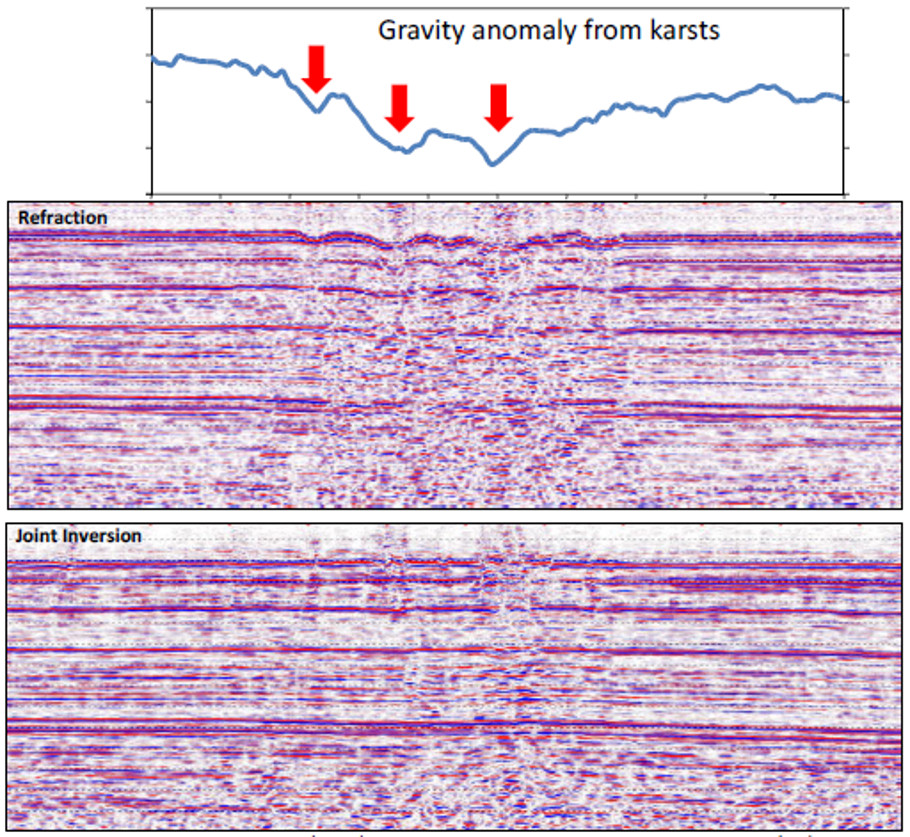DSWI
Baker Hughes’ Deep Shear Wave Imaging (DSWI) processing service helps resolve some of the ambiguities between seismic images and borehole images. It uses body waves generated by an acoustic dipole source to map sub-seismic faults and fractures that would otherwise be invisible with conventional borehole imaging and surface seismic techniques. The acquisition and processing service enables operators to gain critical insight of the reservoir structure, with high-resolution images of formation features located up to 30.5 m (100 ft) away from the borehole. The processing workflow reduces the amount of interpretation input, reducing turnaround time.

The DSWI processing service uses body waves generated by an acoustic dipole source to map sub-seismic faults and fractures. (Source: Baker Hughes)
Ji-Fi
Since the introduction of 3-D seismic data for hydrocarbon exploration, geoscientists have looked to create robust reservoir models from seismic. “Seismic inversion” evolved to realize this goal, but results were often unreliable. It was realized that rock physics relationships, typically different per rock type, were not used adequately in existing methods. A collaboration between Ikon Science Ltd., Tullow Oil Plc and CSIRO successfully addressed these limitations. Using a geology-centric approach, Rok- Doc Ji-Fi integrates regional geological prior information in the inversion of seismic data. The result: quantitative predictions of rocks and fluids.

The RokDoc Ji-Fi facies-based inversion (top) is compared to a model-based simultaneous inversion followed by Bayesian classification to facies (bottom). (Source: Ikon Science)
Multifunctional Nano-Tracers
Saudi Aramco’s Multifunctional Nano-Tracers (MFNT) provide realtime in situ detection. They can be “bar coded” by functionalization to 100 or more unique tracer types and can be detected in situ directly from a wellhead or from multiple tracerinjected commingled wells simultaneously. The MFNTs show low reservoir retention, are inexpensive and environmentally friendly, pose zero safety hazards, and can be detected with no sample preparation in situ in the parts per quadrillion range. With these qualities the MFNTs turn the above drawbacks into a highly advantageous and profitable enterprise.

MFNTs can be ‘bar coded’ by functionalization to 100 or more unique tracer types. (Source: Saudi Aramco)
3-D mapping of reservoir saturation
Saudi Aramco and Schlumberger joined forces to boost the advancements of an emerging electromagnetic (EM) technology and apply a field survey to map saturation in the interwell volumes of widely spaced horizontal wells. Crosswell EM provides the interwell resistivity distribution applied in widely spaced horizontal wells for mapping reservoir saturation. This project deployed the DeepLook-EM system simultaneously in two horizontal wells using coiled tubing conveyance and established performance records for the tool measurements spacing and logging interval and recorded the first 3-D resistivity image from crosswell EM data. Collected resistivity data are interpreted together with wellbore logs to provide interwell comprehensive reservoir water saturation with the objective to evaluate sweep efficiency and ultimately maximize oil production and recovery.

A 3-D resistivity inversion cube from the crosswell EM survey between a horizontal water injector and an oil producer pair, spaced 1.3 km (.80 mile) apart, is shown. Dark blue zones (less than 2 ohm·m) represent reservoir volumes swept by the injected water. A newly drilled slanted well in the interwell area (white trajectory) entered an unswept zone of the reservoir targeting a bypassed oil column within the interwell swept area. (Source: Saudi Aramco)
Seismic and EM Joint Inversion
The Multi-Physics group of Saudi Aramco has developed joint inversion applications with electromagnetics (EM) and gravity for subsalt imaging and salt overburden velocity discrimination. A range of applications was used for subsalt exploration in the Red Sea to provide high-resolution velocity mapping of the near surface through helicopter-borne transient EM (TEM) in joint inversion with seismic. The helicopter TEM seismic joint inversion results, in particular, showed resolution comparable or superior to seismic reflectivity. The integration of the EM with seismic through joint inversion provided sharp velocity models.

The application of a refraction statics approach (top) is compared to the gravity seismic joint inversion modeling and wave equation datuming (bottom). Most of the distortions introduced by the complex shallow section affected by karsting have been removed. (Source: Saudi Aramco; from Colombo et al., 2010)
Recommended Reading
BYOP (Bring Your Own Power): The Great AI Race for Electrons
2025-01-06 - Data-center developers, scrambling to secure 24/7 power, are calling on U.S. producers to meet demand as natgas offers the quickest way to get more electrons into the taps.
Pioneer Energy’s Tech Offers More Pad Throughput, Fewer Emissions
2025-01-14 - Pioneer Energy’s Emission Control Treater technology reduces emissions and can boost a well’s crude yield by 5% to10%, executives say.
Diamondback in Talks to Build Permian NatGas Power for Data Centers
2025-02-26 - With ample gas production and surface acreage, Diamondback Energy is working to lure power producers and data center builders into the Permian Basin.
Paradoxes and Power: Why DeepSeek AI May Be Good News for Energy
2025-03-05 - The lower cost and power demand of DeepSeek could be a positive for AI adoption and result in increased proliferation and demand, an analyst said.
ZENRG Capitalizing on New Investments, Tech to Reduce Emissions
2025-01-07 - ZENRG Services recently secured funding from Chevron, BP Energy Partners and EIC Rose Rock to support its expansion of compression technology that keeps methane from being vented or flared.
Comments
Add new comment
This conversation is moderated according to Hart Energy community rules. Please read the rules before joining the discussion. If you’re experiencing any technical problems, please contact our customer care team.





